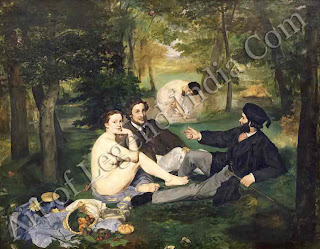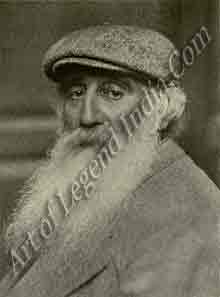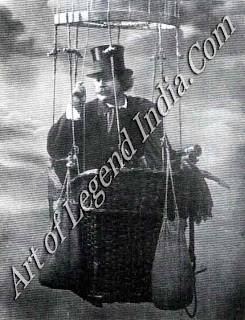The Impressionists in Paris
When
Van Gogh visited Paris in 1874, the Impressionists had just shocked the art
world with their first exhibition. He returned 10 years later to form a 'second
wave', with Gauguin and Lautrec.
Vincent
van Gogh first visited Paris at the age of 21, when he stayed with his brother
Theo. Obsessed by the failure of a love affair, he spent much of his free time
sitting indoors, brooding over the Bible. Vincent had not yet decided to become
a painter, and though both he and Theo worked for a firm of art dealers he was
scarcely aware that a revolution in painting was fomenting in the city.
In
April 1874, just before he arrived, a group of painters known as the
Impressionists had held their first exhibition at a shop owned by the
photographer Nadar, in the Boulevard des Capucines. A mixed band of
individualists, they included the buoyant, self-confident Claude Monet and the
day-dreaming Auguste Renoir, the anarchist Camille Pissarro and the elegant Edgar
Degas.
The
group had come together in 1863, when their father figure, Edouard Manet,
outraged the Paris art world with his Luncheon on the Grass a painting of a
naked woman picnicking with two fully-clothed men. The subject was an affront
to bourgeois taste, and it was turned down by the selection panel of the
Academie des Beaux Arts as unsuitable for showing at the annual exhibition of
the Salon.
In
previous years such a picture would never have reached the public eye. But that
same year, the Emperor Napoleon III had given a new opportunity to rejected
artists by opening a second exhibition, the Salon des refuses especially for them.
Over 1,000 painters showed their works, and Manet's Luncheon caused a
sensation. The academic critics savaged the painting as 'a shameful, open
sore,' but Manet quickly became a hero for the young radicals. They flocked to
his studio for advice and encouragement. And their sense of common purpose was
cemented by meetings in the nearby Café Guerbois.
NIGHTS IN THE CAFE GUERBOIS
Every
Thursday, as the light faded in the evening, the painters would meet up to
discuss their ideas with other leaders of the avant-garde novelists such as
Emile Zola and poets such as Charles Baudelaire and Theophile Gautier. Over
numerous glasses of wine or absinthe, the popular but lethal anise-flavored
drink of the time, they would engage in fierce debate about their artistic
aims. Sometimes the arguments would get out of hand Manet himself was once
almost provoked into fighting a duel there.
For all
but a few of the younger artists, there were two overriding goals to paint the
everyday world around them, and to work in the open air. It was Monet who was
initially most interested in painting landscapes. Others soon followed his
example, for working in the countryside was cheap, and it was stimulating to
have company. The Impressionists would often work together at Bougival and
Argenteuil on the Seine, in the Forest of Fontainebleau, or on the coast of
Normandy.
While
the artists spent much of their time in these tranquil settings, they would
regularly travel to Paris to try to sell some paintings. They found it hard to
make a living. Not only was their work still barred from the official Salon,
where professional artists could attract commissions, but the expensive
galleries of the 'grands boulevards' also re-fused to stock their paintings.
Buyers were hard to find, even with prices as low as 20 to 40 francs.
The
Impressionists were not without minor patrons, such as Pissarro's friends Murer
the confectioner and Dr de Bellio; the singer Faure who collected Mallet; the
civil servant Chocquet who supported Renoir and Cezanne; or the anarchist Pere
Tanguy, a supplier of art materials who gave them all generous credit as well
as paint and canvas in return for their paintings.
But it
was against a background of 'penury, obscurity and growing frustration that the
artists had conceived the idea of a group exhibition, in an attempt to bring
their work directly to the attention of the buying public. Only Manet refused
to exhibit with them: he was exhausted by the ten-year barrage of criticisms
and personal abuse, and no longer wished to expose his work to ridicule.
The
first exhibition, which took place just before Vincent arrived in Paris, proved
a financial failure, and was predictably slammed by the critics as in-decent
'filth'. But it represented the first stage in an outbreak of artistic defiance
which would soon transform the French art world. When Vincent arrived back in
Paris in 1886, the Impressionists were on their way to commercial success.
Eight
exhibitions in 12 years had generated a growing momentum of critical approval.
Renoir had even won approval from the academic establishment, with a painting
prominently displayed at the 1879 Salon, after which Pissarro wrote, 'I do
believe Renoir is launched. So much the better! It's so hard to be poor.' And
if the other Impressionists were still not entirely accepted by the art-buying
clientele, their paintings were now selling in reasonable quantities through
more progressive dealers such as Durand-Ruel who, in 1886, staged a most
successful exhibition in New York.
Theo
himself stocked works by Monet, Degas, Renoir and Pissarro in his Montmartre
gallery and the two brothers would often discuss the new developments. Vincent
was now committed to a painting career, and in a much more receptive frame of
mind altogether. He quickly realized that the Impressionist painters were a
force to be reckoned with.
VAN GOGH MEETS PISSARRO
Shortly
after Vincent's arrival, Theo introduced his brother to Pissarro, who was known
for being sensitive and encouraging to young artists. Vincent had great respect
for Pissarro's judgment. On one occasion, dressed in his characteristic blue
work-man's smock, he stopped his mentor in a busy street and insisted on
showing him his latest can-vases, in full view of mocking passers-by. Pissarro
said later he felt Vincent would either 'go mad or leave the Impressionists far
behind', not realizing that both of these predictions would be entirely
fulfilled.
In
fact, Impressionism had already passed its peak as a dynamic movement. The
leaders had argued with each other, and begun to go in different directions.
With no progressive schools available, Vincent was forced to enrol at an
'official' studio, run by Fernand Cormon, a man who detested Impressionism.
There he made friends with other students including Emile Bernard and Louis
Anquetin, the Australian John Russell and an engaging, rather ugly aristocrat,
Henri de Toulouse-Lautrec. This group, with Paul Gauguin and Georges Seurat,
would soon form a new wave in the Paris art world.
 After a
few months, Vincent and Toulouse-Lautrec left the Cormon studio in frustration.
They had already met other more stimulating painters at Pere Tanguy's art
supplies shop in the back streets of Montmartre. The generous Tanguy, who still
displayed Impressionist works in his shop, one day introduced Vincent to
Cezanne, who also had a reputation for being furiously emotional. It was not an
encouraging meeting. After studying Vin-cent's recent work, Cezanne said
bluntly, 'You certainly paint like a madman.'
After a
few months, Vincent and Toulouse-Lautrec left the Cormon studio in frustration.
They had already met other more stimulating painters at Pere Tanguy's art
supplies shop in the back streets of Montmartre. The generous Tanguy, who still
displayed Impressionist works in his shop, one day introduced Vincent to
Cezanne, who also had a reputation for being furiously emotional. It was not an
encouraging meeting. After studying Vin-cent's recent work, Cezanne said
bluntly, 'You certainly paint like a madman.'
The
volatile circle of artists around Van Gogh styled themselves as the groupe du
petit boulevard', in ironic contrast to the Impressionists who had now made
their way into the galleries of the 'grands boulevards.' Their output was
feverishly prolific, the subjects for paintings often being drawn from the
picturesque Montmartre environment with its windmills and quiet lanes.
Like
the Impressionists before them, these 'Post-Impressionists' spent long hours in
cafés arguing over glasses of absinthe particularly Vincent, his outspoken
friend Gauguin and the urbane Toulouse-Lautrec. One of their favourite haunts
was the tavern Le Tambourin on the Boulevard de Clichy, described by Gauguin as
'a real cut-throat's den.' Its owner, Agostina Segatori, even agreed to display
some of her clients' paintings.
But
while the artists harangued each other in the Café Tambourin till on one occasion
an exasperated customer hit Vincent over the head with a still life they found
it very difficult to get exhibited. Without sales, the group could not me in
the expensive capital. Soon Gauguin and Bernard left Paris for Brittany, and in
1888 Van Gogh took the train to Arles. It would take almost a decade for Paris
to discover its loss.
Writer
– Marshall Cavendish
 After a
few months, Vincent and Toulouse-Lautrec left the Cormon studio in frustration.
They had already met other more stimulating painters at Pere Tanguy's art
supplies shop in the back streets of Montmartre. The generous Tanguy, who still
displayed Impressionist works in his shop, one day introduced Vincent to
Cezanne, who also had a reputation for being furiously emotional. It was not an
encouraging meeting. After studying Vin-cent's recent work, Cezanne said
bluntly, 'You certainly paint like a madman.'
After a
few months, Vincent and Toulouse-Lautrec left the Cormon studio in frustration.
They had already met other more stimulating painters at Pere Tanguy's art
supplies shop in the back streets of Montmartre. The generous Tanguy, who still
displayed Impressionist works in his shop, one day introduced Vincent to
Cezanne, who also had a reputation for being furiously emotional. It was not an
encouraging meeting. After studying Vin-cent's recent work, Cezanne said
bluntly, 'You certainly paint like a madman.'

















0 Response to "Netherlandish Great Artist Vincent Van Gogh - The Impressionists in Paris"
Post a Comment